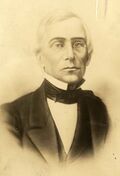Wabash College
Topic: Organization
 From HandWiki - Reading time: 9 min
From HandWiki - Reading time: 9 min
 | |
| Latin: Collegii Wabashensis | |
Former names | The Wabash Teachers Seminary and Manual Labor College (1832–1851) |
|---|---|
| Motto | Scientiae et Virtuti (Latin) |
Motto in English | For Knowledge and Virtue |
| Type | Private liberal arts men's college |
| Established | November 21, 1832 |
Academic affiliations |
|
| Endowment | $385.2 million (2022)[2] |
| President | Scott E. Feller |
Academic staff | 96 full-time and 7 part-time[3] |
| Undergraduates | 835[4] |
| Location | Crawfordsville, Indiana , U.S. [ ⚑ ] : 40°2′17″N 86°54′18″W / 40.03806°N 86.905°W |
| Campus | Suburban, 65 acres (26 ha) [5] |
| Newspaper | The Bachelor[6] |
| |u}}rs | Wabash Scarlet |
| Nickname | Little Giants |
| Mascot | Wally Wabash |
| Website | wabash |
 | |
Wabash College is a private liberal arts men's college in Crawfordsville, Indiana. Founded in 1832 by several Dartmouth College graduates and Midwestern leaders, it enrolls nearly 900 students. The college offers an undergraduate liberal arts curriculum in three academic divisions with 39 majors.[7] As of 2020, it is one of only three private, non-religious, all-male colleges in the United States. [8]
History
The college was initially named The Wabash Teachers Seminary and Manual Labor College, a name shortened to its current form by 1851. Many of the founders were Presbyterian ministers, yet nevertheless they believed that Wabash should be independent and non-sectarian. Patterning it after the liberal arts colleges of New England, they resolved "that the institution be at first a classical and English high school, rising into a college as soon as the wants of the country demand."
Among these ministers was Caleb Mills, who became Wabash College's first faculty member. Dedicated to education in the then-primitive Mississippi Valley area, he would come to be known as the father of the Indiana public education system.
Elihu W. Baldwin, the first president of the college, served from 1835 until 1840. He came from a church in New York City and accepted the presidency even though he knew that Wabash was at that time threatened with bankruptcy. After his death, he was succeeded by Charles White, a graduate of Dartmouth College and the brother-in-law of Rev. Edmund Otis Hovey (1801–1877), a professor at the college.[9] Joseph F. Tuttle, who became president of Wabash College in 1862 and served for 30 years, worked with his administrators to improve town-gown relations in Crawfordsville.[10] Gronert described him "an eloquent preacher, a sound administrator, and an astute handler of public relations." He was the namesake of the former Tuttle Grade School in Crawfordsville (1906), the former Tuttle Junior High School, and the former Tuttle Middle School (1960). Scott E. Feller, Dean of the college from 2014 to 2020 and chemistry professor at Wabash since 1998, became the 17th President of Wabash College on July 1, 2020.
| Name | Date of Inauguration |
|---|---|
| Elihu Baldwin | July 13, 1836 |
| Charles White | July 19, 1841 |
| Joseph F. Tuttle | July 24, 1862 |
| George S. Burroughs | June 21, 1893 |
| William P. Kane | February 22, 1900 |
| George L. Mackintosh | June 12, 1907 |
| Louis B. Hopkins | December 3, 1926 |
| Frank H. Sparks | October 25, 1941 |
| Byron K. Trippet | October 13, 1956 |
| Paul W. Cook | December 3, 1966 |
| Thaddeus Seymour | October 10, 1969 |
| Lewis S. Salter | October 10, 1978 |
| F. Sheldon Wettack | December 3, 1989 |
| Andrew T. Ford | January 29, 1994 |
| Patrick E. White | January 27, 2007 |
| Gregory D. Hess | October 11, 2013 |
| Scott E. Feller | October 8, 2021 |
In the early 1900s, the college closed its "Preparatory School", which prepared incoming students from less-rigorous rural high schools that lacked the courses required for entrance to the college.[11]
During World War II, Wabash College was one of 131 colleges and universities[12] that offered students a path to a Navy commission as part of the V-12 Navy College Training Program.[13]
In 1996, Wabash became the first college in America to stage Tony Kushner's Angels in America.[14]
Academics
| University rankings | |
|---|---|
| National | |
| Forbes[15] | 280 |
| Liberal arts colleges | |
| U.S. News & World Report[16] | 59 |
| Washington Monthly[17] | 75 |
Curriculum
Wabash College's curriculum is divided into three: Division I, Division II, and Division III representing the natural sciences, humanities and arts, and social sciences respectively. Wabash offers 25 academic programs as majors and 32 accompanying minors.[18] Its most popular majors, by 2021 graduates, were:[19]
- Rhetoric (21)
- Economics (20)
- History (18)
- Religion/Religious Studies (15)
- Experimental Psychology (14)
- English Language and Literature (11)
- Biology/Biological Sciences (10)
Comprehensive exams
Seniors at Wabash College take a three-day comprehensive exam in their major subject area. There are two days of written exams and one day of oral exams. The two days of written exams differ by major, but the oral exams are relatively uniform. A senior meets with three professors, one from his major, another from his minor, and a third professor who represents an outside perspective, and can be from any discipline. Over the course of an hour a senior answers questions from the professors which can relate to anything during his studies at Wabash. A senior must pass the comprehensive examinations in order to be eligible for a degree.
Student life
Student culture and traditions
On "Ringing In Saturday", incoming students are addressed by the dean of students, the dean of admissions, the president of the alumni association, and the college president and are "rung in" by the president, using the same bell that Caleb Mills used to call students to class. On Homecoming weekend, students are given the opportunity to show how well they know the college fight song (Old Wabash) during "Chapel Sing".
Student government
The student government, referred to collectively as the Student Body of Wabash College, comprises executive and legislative branches.[20]
Student organizations
Student organizations at Wabash receive funding and recognition from the Student Senate. This funding in turn comes from a student activities fee, which every attendee of the college must pay each semester. The student paper of Wabash College is The Bachelor and has been published since the early 1900s.[21]
Gentleman's rule
Rather than an explicit student code of conduct, Wabash has a single rule:
The student is expected to conduct himself at all times, both on and off campus, as a gentleman and a responsible citizen.[22]
The college says that this rule is its oldest tradition.
Fraternities
The first fraternity, Beta Theta Pi, appeared at Wabash in 1846 and has been on campus continuously since. It was quickly followed by Phi Delta Theta and others. Many of the traditions of the college were begun and are maintained by the fraternities, both individually and collectively. On average, 50–60% of students belong to one of the campus's ten national fraternities.[23]
Endowment
As of August 1, 2021, the value of Wabash's endowment was approximately $400 million, which places Wabash among the richest colleges in the nation in per-student endowment. The endowment was created primarily over the past 70 years using major campaigns and estate planning with alumni. Major donors include the pharmaceutical industrialist Eli Lilly, the company his grandfather founded, his heirs, and the Lilly Endowment. The school's library is named after him as are a number of premier scholarships including the Lilly Award, the college's most prestigious scholarship established in 1974 to honor the Eli Lilly family and recognize young men of outstanding character, creativity, and academic accomplishment. During the most recent capital campaign, "Challenge of Excellence", between fall 2010 and 1 October 2012, the college raised $68 million, exceeding the original goal of $60 million.[24]
Athletics
The school's sports teams are called the Little Giants. They participate in the NCAA's Division III and in the North Coast Athletic Conference for all but one of their 12 varsity sports. The only exception is volleyball, the school's newest varsity sport, which was added in advance of the 2021 season (2020–21 school year). Since the NCAC sponsors volleyball only for women, the Little Giants play that sport in the single-sport Midwest Collegiate Volleyball League. Every year since 1911, Wabash College has played rival DePauw University in a football game called the Monon Bell Classic. The rallying cheer of Wabash College athletics is "Wabash always fights". Wabash College competes in men's intercollegiate baseball, basketball, tennis, cross country, lacrosse, track and field, golf, football, soccer, swimming and diving, volleyball, and wrestling.
Inter-collegiate football at Wabash dates back to 1884, when student-coach Edwin R. Taber assembled a team and defeated Butler University by a score of 4–0 in the first intercollegiate football game in the history of the state of Indiana .[25]
National rankings
In 2020 Wabash was ranked joint 59th best national liberal arts college in the annual U.S. News & World Report.[26] Wabash College is also listed in Loren Pope's Colleges That Change Lives.
Notable people
See also
- Modular Neutron Array
- 1922 National Intercollegiate Basketball Tournament
References
- ↑ "Member Center – Wabash College". National Association of Independent Colleges and Universities. http://member.naicu.edu/member_center/member/wabash.
- ↑ As of June 30, 2022. U.S. and Canadian Institutions Listed by Fiscal Year (FY) 2022 Endowment Market Value (Report). https://www.nacubo.org/-/media/Nacubo/Documents/research/2022-NTSE-Public-Tables--Endowment-Market-Values--FINAL.ashx?la=en&hash=362DC3F9BDEB1DF0C22B05D544AD24D1C44E318D.
- ↑ "College Navigator - Wabash College". https://nces.ed.gov/collegenavigator/?q=Wabash+College&s=all&id=152673.
- ↑ "College Navigator - Wabash College". https://nces.ed.gov/collegenavigator/?q=Wabash+College&s=all&id=152673.
- ↑ "About Wabash - Facts and Figures". Wabash College. https://wabash.edu/aboutwabash/facts.
- ↑ "Our Student Newspaper, the Bachelor". https://www.wabash.edu/bachelor/.
- ↑ "Academics" (in en). https://wabash.edu/academics/majors.
- ↑ Muniz, Hannah. "Are There Any All-Male Colleges Left?" (in en-us). https://blog.prepscholar.com/all-male-colleges.
- ↑ Gronert: pp. 66–67.
- ↑ Gronert: pp. 205–06.
- ↑ Gronert: pp. 30–31, 107.
- ↑ Henry C. Herge (1996). Navy V-12, Vol. 12. Turner Publishing Co., 1996. ISBN 9781563111891. https://books.google.com/books?id=utiWeaPsyvQC&pg=PA22. Retrieved September 22, 2011.
- ↑ "V12 Reunion Brings Back Unique Alumni Group". Crawfordsville, Indiana: Wabash College. 2011. http://www.wabash.edu/news/displaystory.cfm?news_ID=3845.
- ↑ "Wabash College, One of a Dying Breed". 1999. https://www.usnews.com/usnews/culture/articles/990208/archive_000234.htm.
- ↑ "America's Top Colleges 2019". Forbes. https://www.forbes.com/top-colleges/list/.
- ↑ "Best Colleges 2021: National Liberal Arts Colleges". U.S. News & World Report. http://colleges.usnews.rankingsandreviews.com/best-colleges/rankings/national-liberal-arts-colleges.
- ↑ "2020 Liberal Arts Rankings". Washington Monthly. https://washingtonmonthly.com/2020college-guide/liberalarts.
- ↑ "Academic Programs A–Z < Wabash College" (in en). http://bulletin.wabash.edu/programsaz/.
- ↑ "Wabash College". U.S. Dept of Education. https://nces.ed.gov/collegenavigator/?q=Wabash&s=all&id=152673#programs.
- ↑ "Constitution of the Student Body of Wabash College". https://blog.wabash.edu/studentsenate/wp-content/uploads/sites/20/2018/08/Student-Senate-Constitution-2018-Update.pdf.
- ↑ Depalma, Anthony (April 22, 1992). "Picture a Men's College Circa '56; That's Wabash". The New York Times. https://www.nytimes.com/1992/04/22/education/picture-a-men-s-college-circa-56-that-s-wabash.html.
- ↑ "The Gentleman's Rule". https://www.wabash.edu/aboutwabash/rule.
- ↑ "Most Students in Fraternities | Rankings | US News". Colleges.usnews.rankingsandreviews.com. http://colleges.usnews.rankingsandreviews.com/best-colleges/rankings/most-frats.
- ↑ "The Challenge of Excellence". Wabash College. http://www.wabash.edu/excellence/home.cfm.
- ↑ Ancestry.com Edwin R. Taber
- ↑ "National Liberal Arts College Rankings | Top Liberal Arts Colleges | US News Best Colleges". Colleges.usnews.rankingsandreviews.com. 2020-12-09. https://www.usnews.com/best-colleges/rankings/national-liberal-arts-colleges?schoolName=Wabash+College.
- Gronert, Theodore G. (1958). Sugar Creek Saga: A History and Development of Montgomery County. Wabash College.[ISBN missing]
- Harvey, Robert S., ed. (1982). These Fleeting Years: Wabash College 1832–1982. Crawfordsville: R.R. Donnelley & Sons Co. [ISBN missing]
External links
 |
 KSF
KSF
